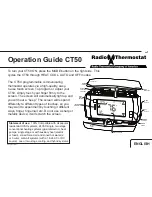
Advanced Operation
Z33085_2_002
23
Technical Considerations
When adding a thermometer substance to the sample, there are a few technical points to
consider.
Depending on your NMR system (room temperature or cryogenically cooled probe,
spectrometer frequency etc.) you need to add a sufficient amount of the compound in order to
obtain a decent lock signal. Another concern is the distance from the
2
H signal which is used
for the field lock (figure below). In addition, the dynamic range, which is the intensity ratio of
the
2
H signal used for frequency lock and the NMR Thermometer, plays an important role
when a highly or fully deuterated solvent (e.g. D
2
O) is used as a field lock solvent.
The requirements for obtaining reliable lock-in and lock regulation performance include:
• S/N (
2
H) > about 200:1 (signal > ~3 ppm distant from the main signal)
• Intensity ratio < 500:1 (field lock signal: frequency lock signal; ∆ ~3 ppm)
The smaller the distance to the second signal, the higher the concentration of the compound
used for the NMR Thermometer should be. As a rule of thumb: reducing the distance of the
two lock signals by a factor of 2 increases the necessary concentration (decreases the
possible intensity ratio of the two signals) of the NMR Thermometer compound by the same
factor. Examples:
• The D of the NMR Thermometer signal to the field lock signals is about 3 ppm. The
required signal to noise ratio of the NMR Thermometer compound has to be at least 200:1
(I-ratio <500:1).
• The D of the NMR Thermometer signal to the field lock signals is about 1.5 ppm. The
required signal to noise ratio of the NMR Thermometer compound has to be at least
400:1(I-ratio <250:1).
• If the field lock signal in very large (for example using pure D
2
O) the concentration of the
NMR Thermometer compound has to be adjusted accordingly (see figure below).
Thermometer substances with a signal closer than 1 ppm to the field lock signal are critical
and should not be selected as NMR Thermometer signals.
Figure 5.7: Approximate dynamic range of field lock (blue) vs. the NMR Thermometer signal (red) if the
S/N of the frequency lock signal is sufficient (> 200:1).
5.2.2
Summary of Contents for NMR
Page 4: ...Contents 4 Z33085_2_002...
Page 6: ...Introduction 6 Z33085_2_002...
Page 8: ...Principle of NMR Thermometer 8 Z33085_2_002...
Page 10: ...Requirements 10 Z33085_2_002...
Page 32: ...Frequently Asked Questions FAQ 32 Z33085_2_002...
Page 34: ...Contact 34 Z33085_2_002...
Page 36: ...List of Figures 36 Z33085_2_002...
Page 38: ...Index 38 Z33085_2_002...
Page 39: ...Z33085_2_002 39...
Page 40: ...Bruker Corporation info bruker com www bruker com Order No Z33085...
















































